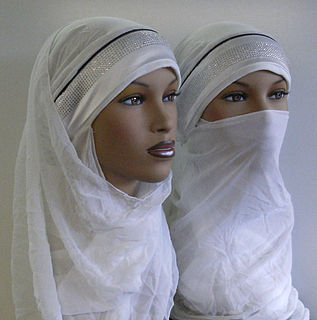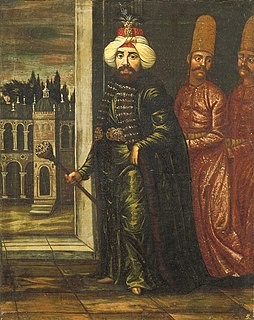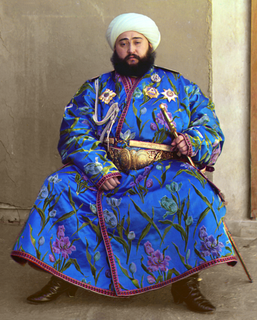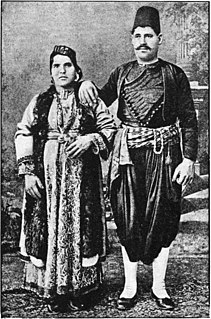 W
WOttoman clothing or Ottoman fashion is the style and design of clothing worn during the Ottoman Empire.
 W
WA bashlyk, also spelled bashlik, is a traditional Turkic, Caucasian, Iranian, and Cossack cone-shaped headdress hood, usually of leather, felt or wool, an ancient round topped felt bonnet with lappets for wrapping around the neck. Local versions determine the trim, which may consist of decorative cords, embroidery. metallized strings, fur balls or tassels. Among dozens of versions are winter bashlyks worn atop regular headdress, cotton bashlyks, homeknitted bashlyks, silk bashlyks, scarf bashlyks, down bashlyks, dress bashlyks, jumpsuit-type bashlyks, etc. Bashlyks are used as traditional folk garment, and as uniform headdress.
 W
WÇarşaf, also written as charshaf, is a simple, loose over-garment, essentially a robe-like dress. It is a Turkish version of Arabic Abaya and also similar to the niqab and the chador. Literally translated, çarşaf means "bed sheet".
 W
WThe official court uniform and dress of the Ottoman Empire were required to be worn by those in attendance at the imperial court in the nineteenth century, with the aim of being on the same line as most European nations. It consisted of European-inspired clothing in the Empire style. It was introduced during the early stages of the Tanzimat modernization period until the end of the First World War.
 W
WThe somewhat vaguely defined term dolman can refer to various types of clothing, all of which have sleeves and cover the top part of the body, and sometimes more. Originally, the term dolaman referred to a long and loose garment with narrow sleeves and an opening in the front. Generally worn by Turks, it resembled a cassock in shape.
 W
WThe fez, also called tarboosh, is a felt headdress in the shape of a short cylindrical peakless hat, usually red, and sometimes with a tassel attached to the top. The name "Fez" refers to the Moroccan city of Fez, where the dye to colour the hat was extracted from crimson berries. The modern fez owes much of its popularity to the Ottoman era.
 W
WThawb, also spelled thobe or tobe and known by various other names in different regions, is an ankle-length dress, usually with long sleeves. It is commonly worn in the Arabian Peninsula and the Middle East, Iran, neighbouring Arab countries, and some countries in East and West Africa. An izaar is typically worn underneath.
 W
WA kaftan or caftan is a variant of the robe or tunic; originating in Asia, it has been worn by a number of cultures around the world for thousands of years. In Russian usage, kaftan instead refers to a style of men's long suit with tight sleeves. Though the kaftan is of ancient Mesopotamian origin, it has been used by many West and Southwest Asian ethnic groups. It may be made of wool, cashmere, silk, or cotton, and may be worn with a sash. Popular during the time of the Ottoman Empire, detailed and elaborately designed garments were given to ambassadors and other important guests at the Topkapi Palace. Variations of the kaftan were inherited by cultures throughout Asia and were worn by individuals in Russia, Southwest Asia and Northern Africa Styles, uses, and names for the kaftan vary from culture to culture. The kaftan is often worn as a coat or as an overdress, usually having long sleeves and reaching to the ankles. In regions with a warm climate, it is worn as a light-weight, loose-fitting garment. In some cultures, the kaftan has served as a symbol of royalty.
 W
WA robe of honour was a term designating rich garments given by medieval and early modern Islamic rulers to subjects as tokens of honour, often as part of a ceremony of appointment to a public post, or as a token of confirmation or acceptance of vassalage of a subordinate ruler. They were usually produced in government factories and decorated with the inscribed bands known as ṭirāz.
 W
WThe tantour (tantoor) was a form of cone-shaped woman's headdress similar to the hennin, popular in the Levant during the nineteenth century, but seldom seen after 1850.
 W
WThe taqiyah or araqchin is a short, rounded skullcap. It is often worn for religious purposes; for example, Muslims believe that the Islamic prophet Muhammad used to keep his head covered, therefore making it mustahabb. Muslim men often wear them during the five daily prayers.
 W
WTiraz are medieval Islamic embroideries, usually in the form of armbands sewn onto robes of honour (khilat). They were bestowed upon high-ranking officials who showed loyalty to the Caliphate, and given as gifts to distinguished individuals. They were usually inscribed with the ruler's names, and were embroidered with threads of precious metal and decorated with complex patterns. Tiraz were a symbol of power; their production and export were strictly regulated, and were overseen by a government-appointed official.
 W
WA turban is a type of headwear based on cloth winding. Featuring many variations, it is worn as customary headwear by people of various cultures. Communities with prominent turban-wearing traditions can be found in the Indian subcontinent, Southeast Asia, the Arabian Peninsula, the Middle East, the Balkans, the Caucasus, Central Asia, North Africa, West Africa, East Africa, and amongst some Turkic peoples in Russia as well as Ashkenazi Jews.
 W
WTurkish şalvar, Turkish trousers or dimiye are traditional baggy trousers gathered in tightly at the ankle. Men may wear the traditional loose coat, called a jubba, over the şalvar. Mustafa Kemal Atatürk changed the dress code in Turkey in the 1920s as part of his reforms. However, men and women still wear the şalvar in many areas of Turkey, indifferent to social status.
 W
WA yashmak, yashmac or yasmak is a Turkish and Turkmen type of veil or niqāb worn by women to cover their faces in public. Today there is almost no usage of this garment in Turkey. In Turkmenistan, however, it is still consciously used by some married women in the presence of elder relatives of a husband.
 W
WA yelek is the bodice or waistcoat of an Ottoman female dress(also for men). The yelek is typically a sleeveless and collarless garment and usually has small pockets on the sides. Traditional yeleks are generally embroidered and made out of silk cloth as well as velvet and leather. During the Ottoman era, the yelek was a hip-length jacket or vest worn for warmth by both sexes. It could have long sleeves, short sleeves, or no sleeves, and often had a small standing collar. A shorter variant, the anteri was also popular.